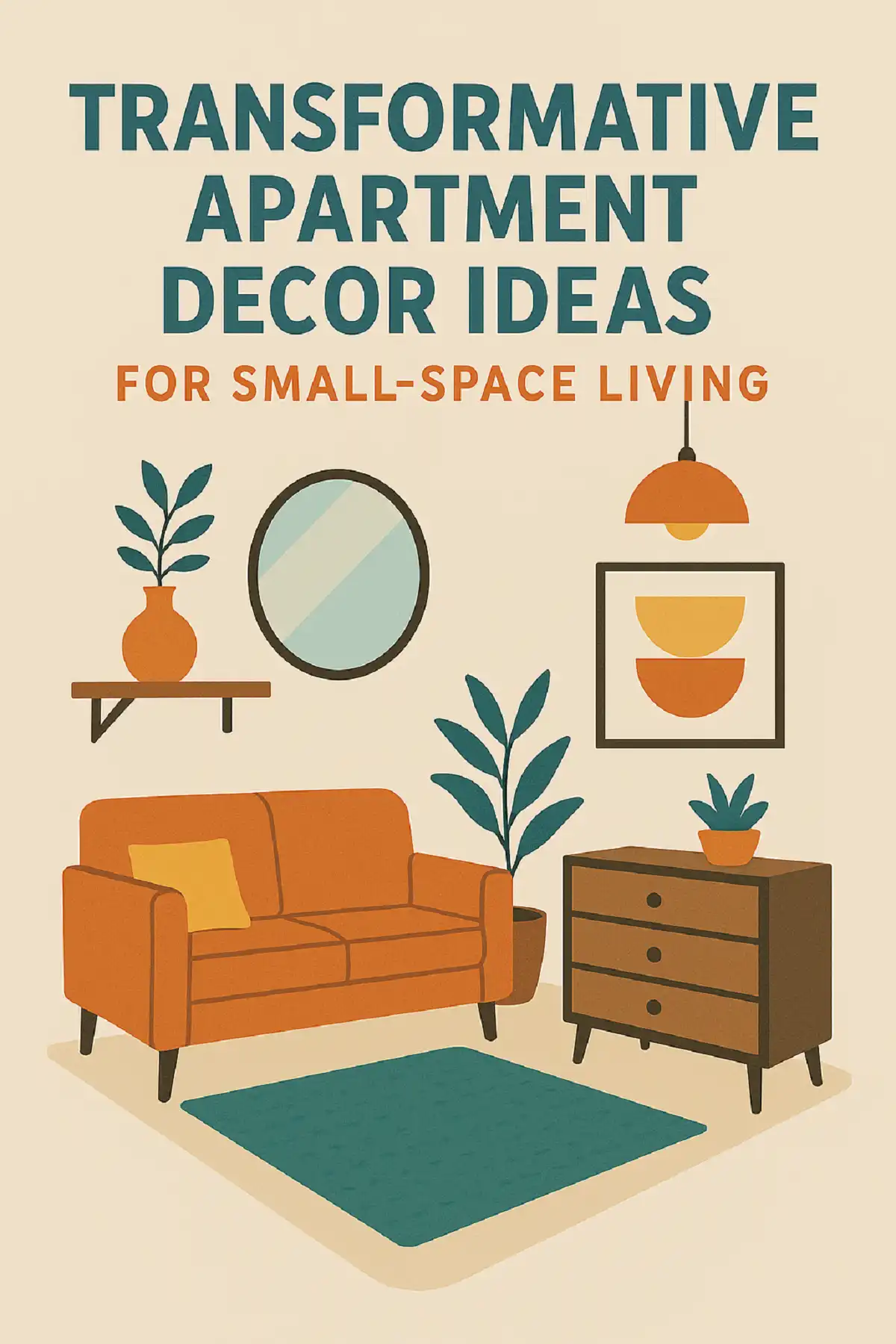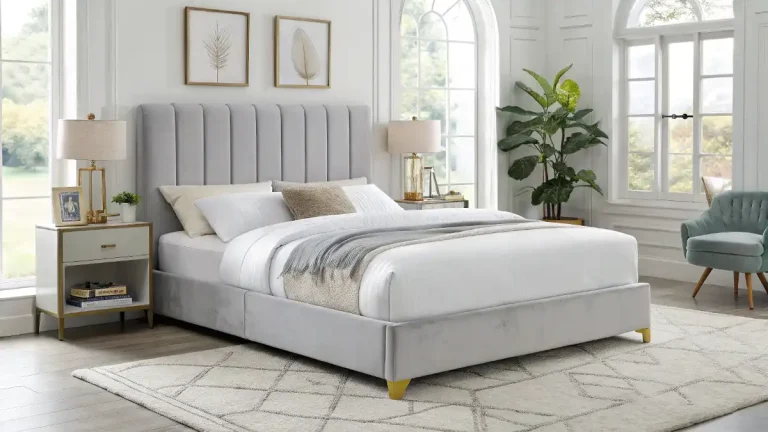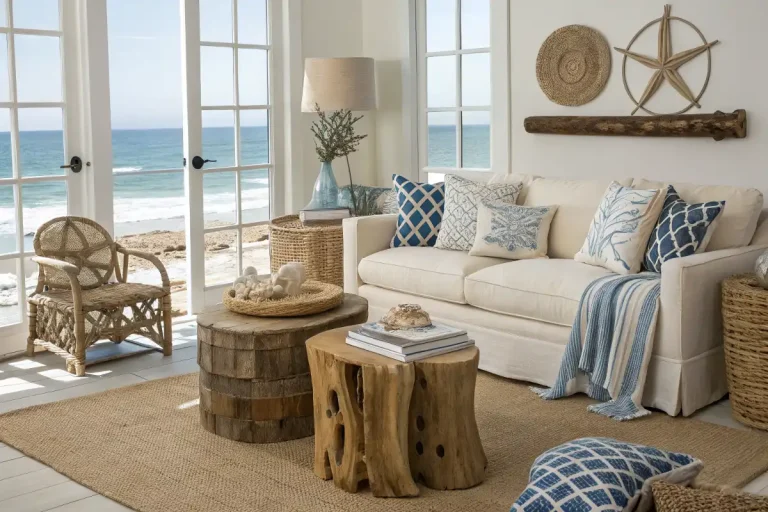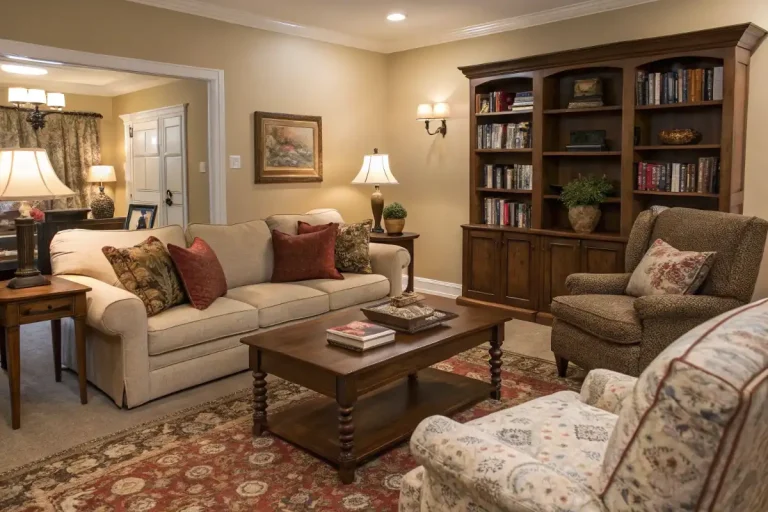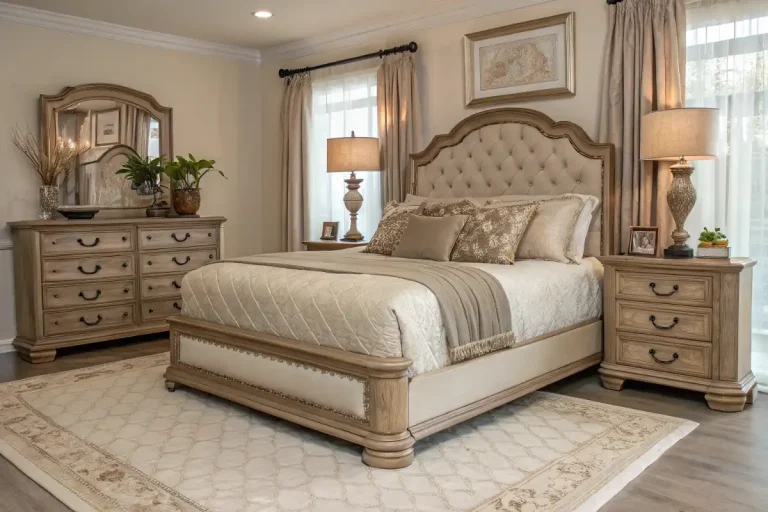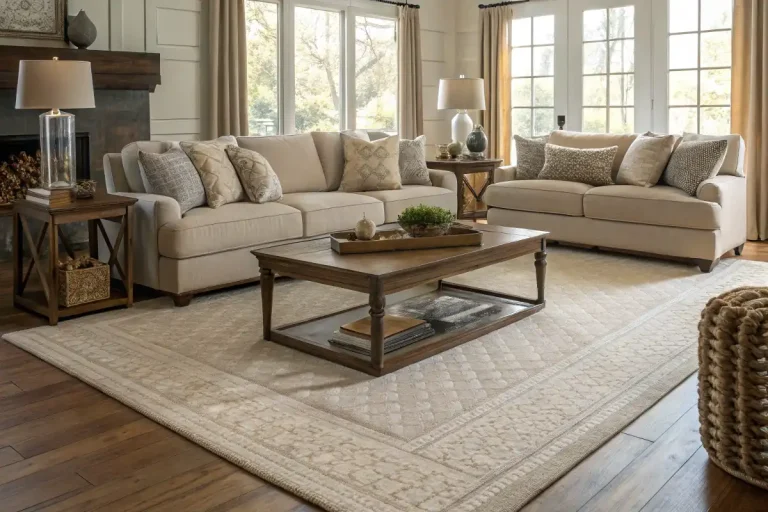How to design Small Apartment Decor to Maximize Space & Style
Decorating a small rental apartment is all about combining smart design with personal style. You want your home to feel cozy and family-friendly, even if every square foot counts. The good news is that today’s decor trends and tech tools make it easier than ever to turn a tiny space into a functional, inviting home. From high-tech space-planning apps to budget-friendly DIY tricks, each of these apartment decor ideas is renter-approved and family-friendly. We’ve gathered 15 of the most effective tips for small-space living, focusing on safety, style, and comfort.
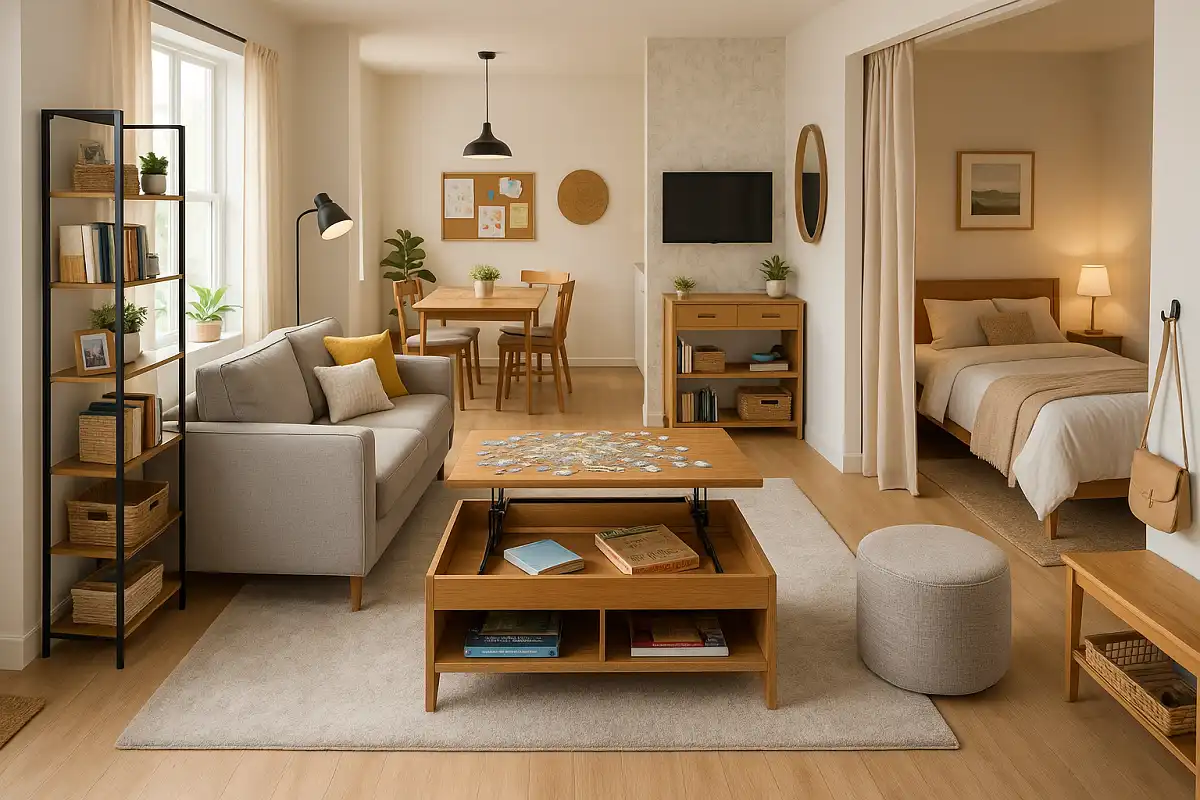
Table of Contents
Smart Layout Planning Tools
Before moving a single piece of furniture, get a clear floor plan. Use free apps like Room Planner or MagicPlan to scan your apartment with your phone and experiment with layouts. These tools let you see how much space each item will take and ensure you leave enough walking clearance (at least 2–3 feet around beds and sofas). Even small adjustments—like pulling furniture a few inches off the walls—can make a room feel airier and allow natural light to flow around the space. In many cases, floating a couch 4–6 inches from the wall creates the illusion of depth. Treat this like a mini project: sketch out zones (sleep, work, play) and arrange furniture for easy flow. Proper planning prevents surprises and makes everyday life smoother for busy families.
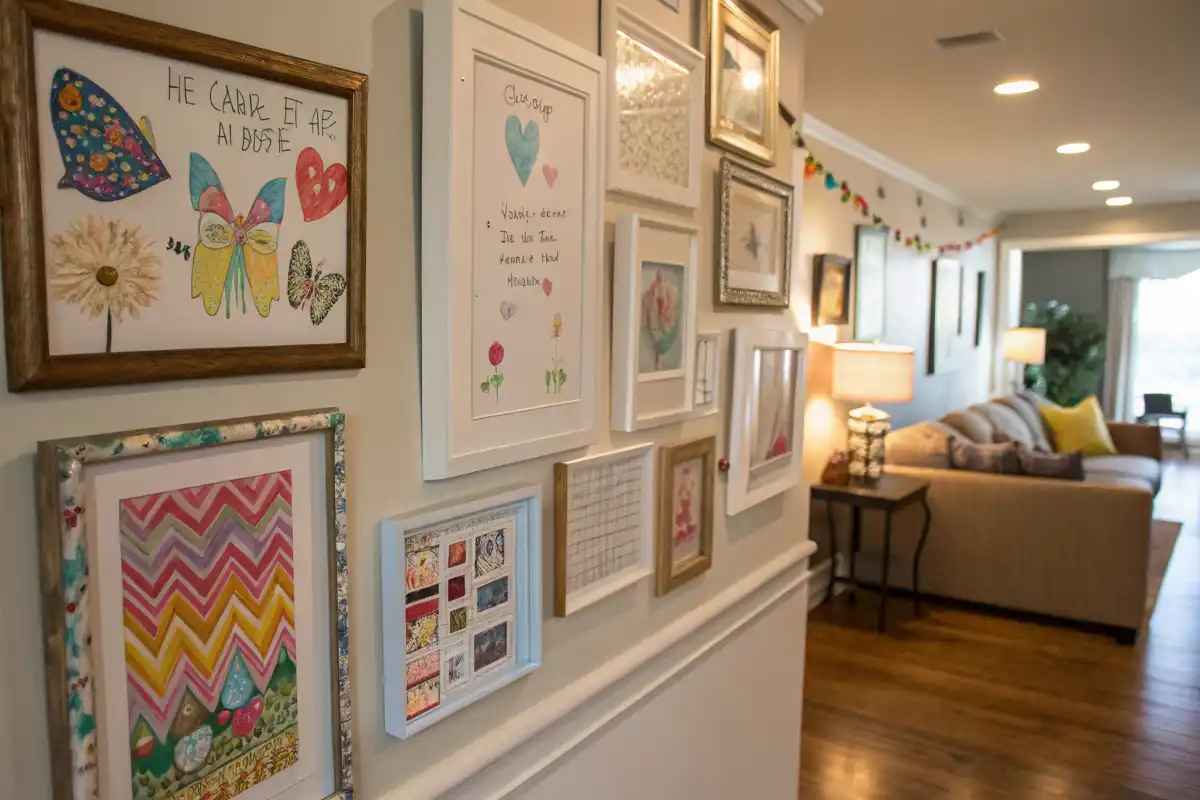
Flat furnishing ideas: Apartment Furnishing Solutions
Multifunctional Furniture
In small apartments, one piece of furniture often needs to do double or triple duty. Look for living room furniture with built-in storage—like storage ottomans, bench seats with hidden compartments, or sofas that unfold into guest beds. A sofa bed or daybed serves as seating by day and a bed by night; many modern designs are surprisingly stylish. Height-adjustable desks are another smart buy: they work as a work-from-home station or a craft table and can be lowered for family game nights or kids’ homework. Try to pick pieces that fit your lifestyle: for example, choose a dining table that folds up when not in use or stool seats that stack under a console table. Even an accent chair with a lofted frame (think “chair on stilts”) can provide storage space for baskets underneath. Investing in just a few multifunctional pieces is a classic apartment decor idea that instantly frees up floor space and keeps clutter out of sight.
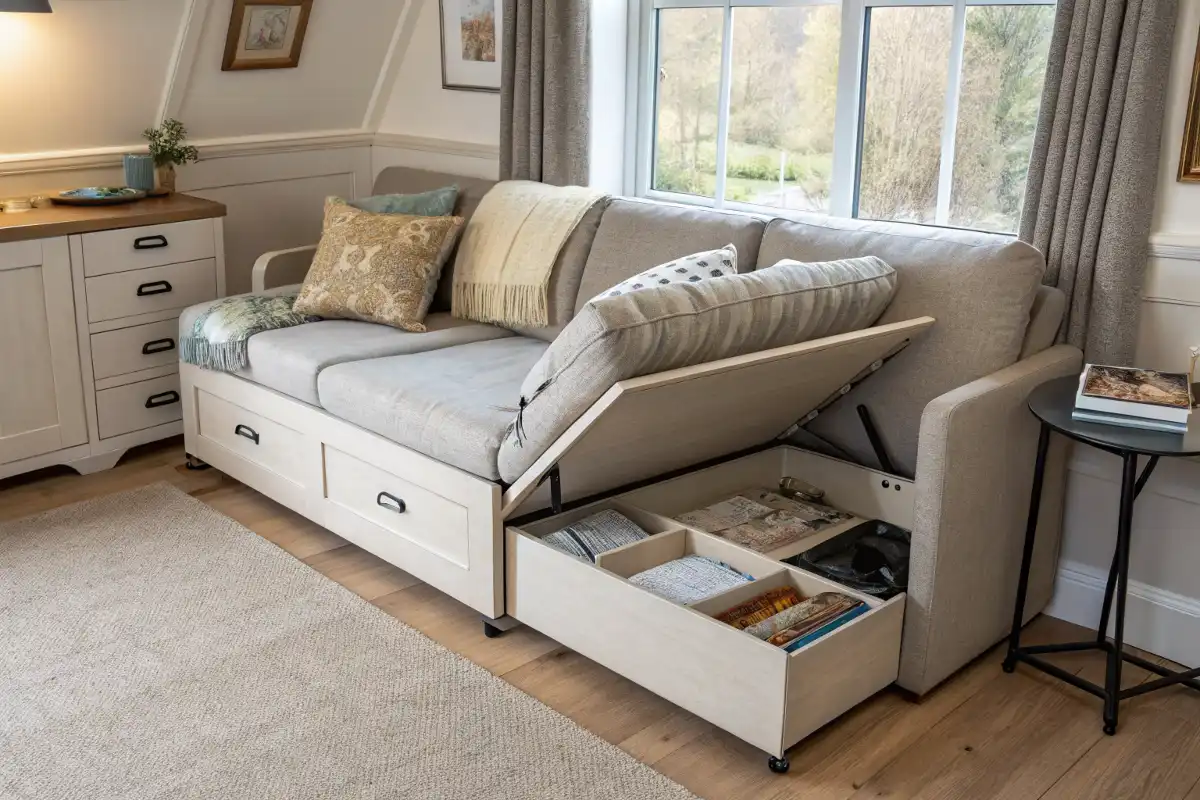
Flexible Room Dividers
Small studios and open-plan layouts benefit greatly from versatile dividers. Instead of permanent walls, use tall shelving units, rolling screens, or floor-to-ceiling curtains to define zones. An open-backed bookcase or metal grid can separate the bedroom nook from the living area while adding display space. Hang a curtain on a tension rod (no drilling required) to carve out a private sleeping corner, or set up a lightweight foldable screen in front of a study space. For added privacy and sound control, consider adhesive acoustic panels or large fabric wall hangings on the divider; these absorb noise (a plus if kids are napping) and add texture. The key is flexibility: when you need an open, airy room for family movie night, push the divider aside; when it’s bedtime, your child’s loft bed retreat or home office is pleasantly tucked away (studio apartment inspiration).
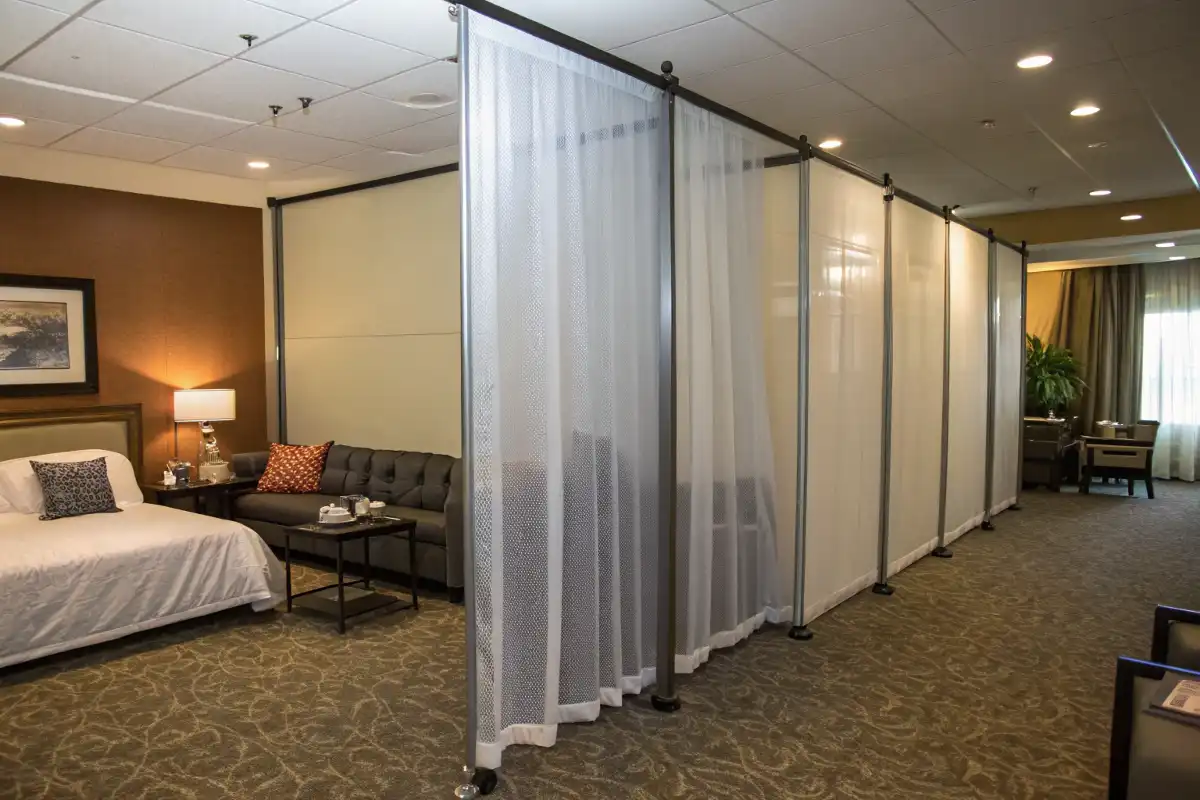
Vertical Storage Solutions
When floor space is limited, look up! Use vertical space in every room to store items up to the ceiling (with caution for weight limits). In the kitchen, install a magnetic rail or stick-on pegboard on the wall for utensils, pots, or even spice jars; this keeps counters clear. Living areas can sport tall, narrow bookcases or wall-mounted shelves. Bedrooms can benefit from stackable cube storage reaching high, filled with bins for out-of-season clothes or rarely-used items. For very high ceilings, ceiling-mounted hooks or pulleys are great for hanging bicycles, plants, or beach chairs. Remember to keep heavy objects low (below shoulder height) and lighter boxes higher up, both for safety and to prevent stubborn landlord “no drilling” rules being broken. Even in a small kitchen, adding floating shelves just a foot or two apart can increase usable storage by more than 50% without overcrowding. By thinking vertically, you turn every inch of wall into useful space and keep clutter off the floor—an essential tactic in any smart small-apartment decor plan.

Layered Organization (“Triple-Zone” System)
Along with going vertical, organize your belongings by level. A simple zone system makes items easy to find and keeps daily life flowing. For example, designate: (1) Floor-to-3-feet for bulky or frequently accessed things (toy baskets, shoe racks, pet supplies), (2) Mid-wall (3–6 feet) for everyday items (kitchen dishes, books, office supplies), and (3) High shelves (above 6 feet) for storage boxes or seasonal gear. In your closet, use a low bench for shoes, mid-level racks for clothes you wear most, and top-shelf bins for out-of-season gear. In the kitchen, put heavy pots on lower shelves, everyday plates at eye-level, and rarely-used bakeware up top. This vertical “layer cake” approach uses every shelf and keeps the back of the closet accessible. It’s an especially helpful system for families, since kids can reach their own shelf of toys (middle zone) while holiday decorations go safely out of reach on top.
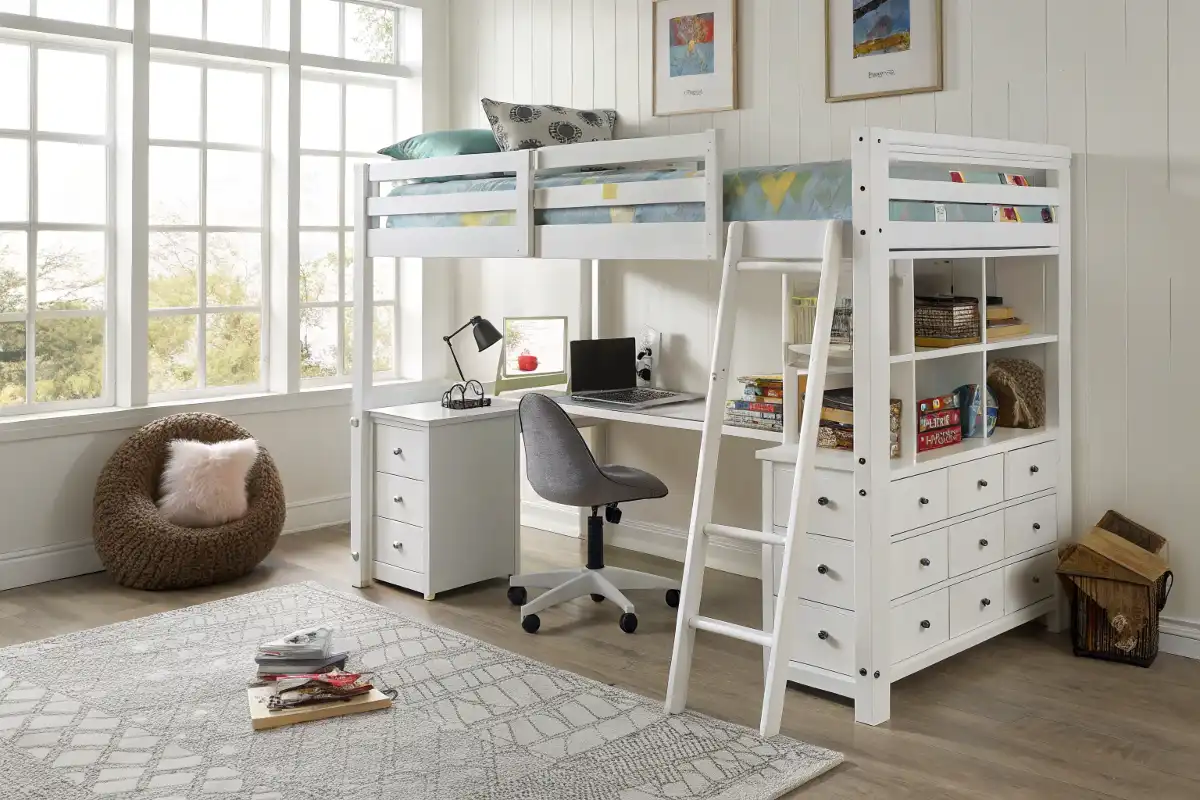
Small sofa guide: Compact Sofas For Small Spaces
Calming Color and Biophilic Accents
Color and plants can transform small spaces without costing much or damaging walls. Instead of plain white, build a calming palette: think muted sage greens, soft terracotta, or pale blues for the majority of your walls and decor. These earthy or nature-inspired tones make a room feel warm and cohesive. Reserve around 70% of your color scheme for these soothing base tones, 20% for textured accents like a woven rug or jute lampshade, and 10% for a punch of something lively (a lavender throw pillow, a rich blue ottoman). For families, light walls and ceilings are still best to keep the room bright. You might apply a light-reflective paint on the ceiling to bounce natural light—some paints even have tiny glass beads for extra shimmer. Add biophilic elements by placing a few hardy houseplants or a small potted herb garden on a sunny ledge or windowsill; not only do they clean the air, but the green life makes a home feel more tranquil. Even removable moss wall panels or a simple piece of driftwood art can bring the outdoors in without violating your lease. These natural touches help balance all the gadgets and hard surfaces in a small apartment, creating an inviting family-friendly vibe.
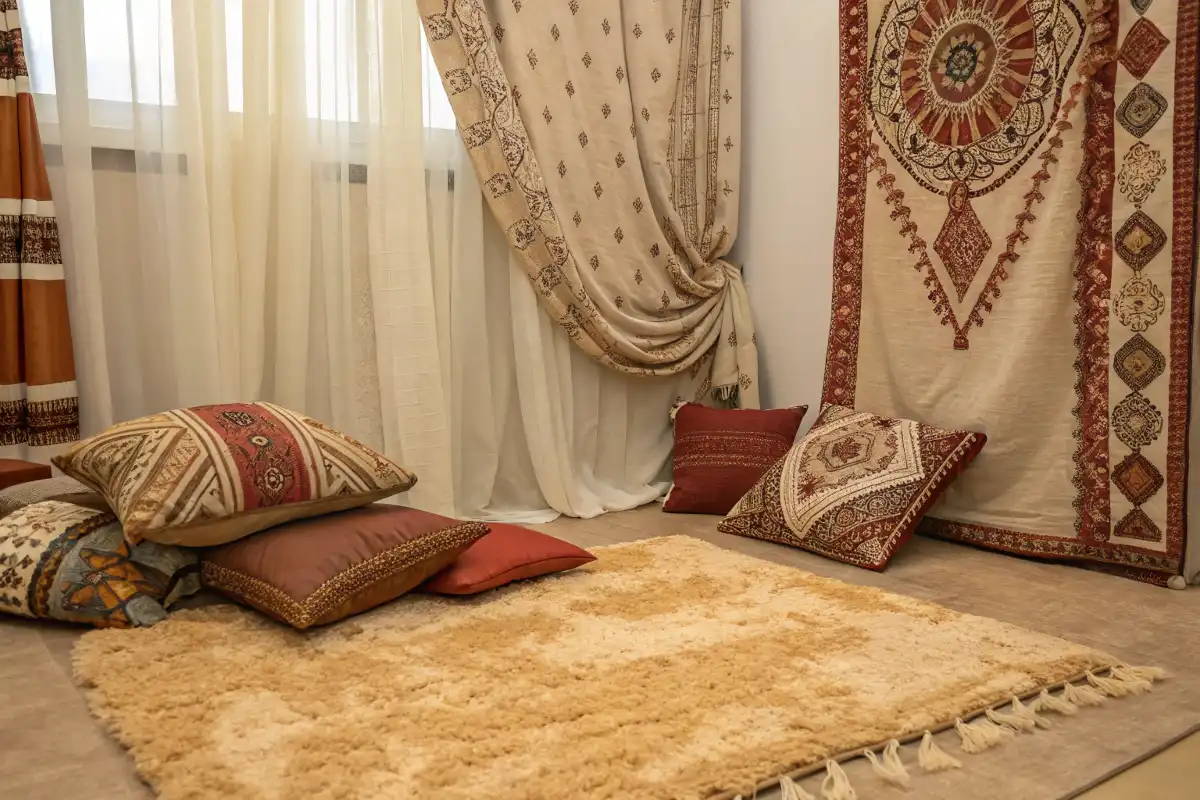
Soft Textures and Sound Control
Small homes can sometimes feel loud or echoey when there aren’t enough soft materials. Combat this with texture. Cozy rugs are a must in each room (especially if you have young kids on the floor): they define areas and absorb noise. A plush rug under the coffee table or dining area instantly adds warmth. Use throw pillows and blankets in tactile fabrics (think cotton, chenille, or faux fur) on sofas and chairs. Window treatments also play a dual role: thick curtains or Roman shades will soften the look of the room and help deaden street or hallway noise. If outside noise is a problem, adhesive-backed acoustic panels (or even decorative fabric wall hangings) can be placed on the wall behind a sofa or bed to muffle sound. Furniture materials can contribute too: a mix of wood, rattan, and metal adds visual interest (for example, a recycled teak end table next to an aluminum-framed chair). For families, these textures make a space feel livable and kid-friendly — no one minds sitting on a cushioned chair with a spill than a stark metal frame. By thoughtfully layering fabrics and soft surfaces, your apartment will feel quieter, warmer, and more welcoming. (space-defining rugs)
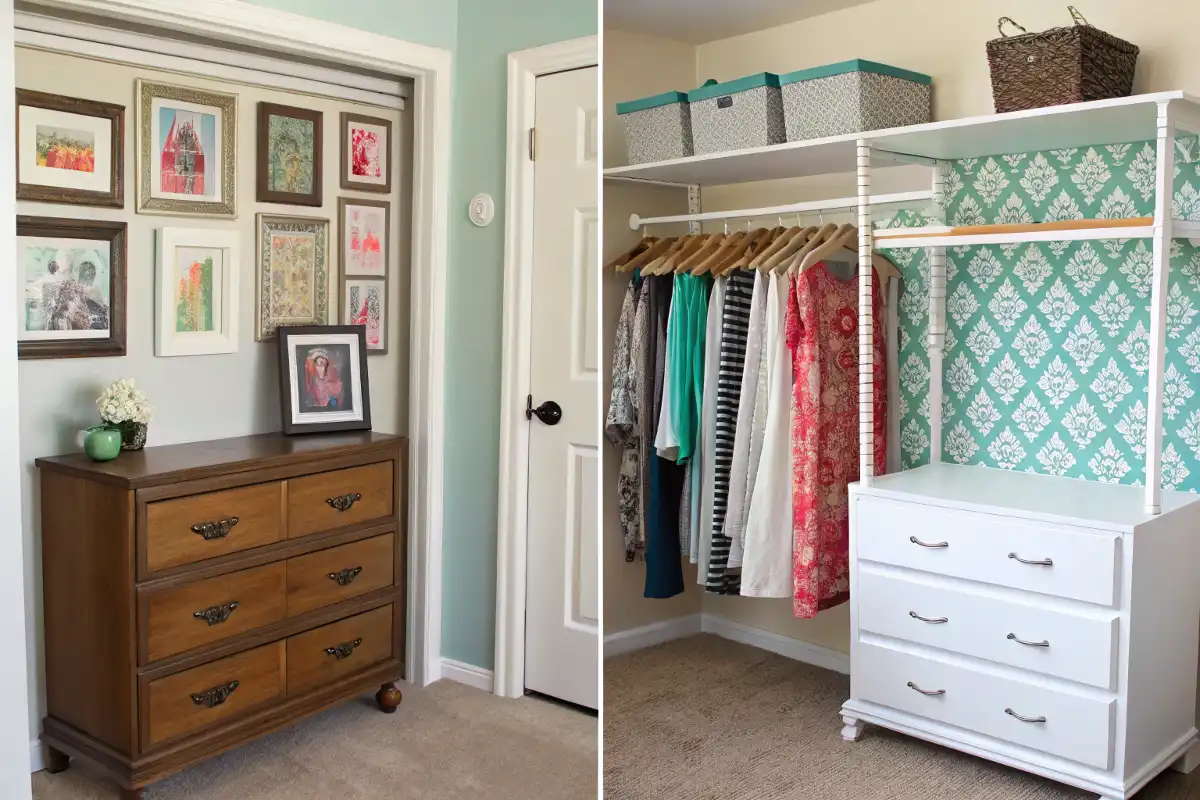
Layered, Smart Lighting
Good lighting is both practical and decorative, especially in rentals where you might not replace the ceiling fixture. Aim for layered lighting: combine ambient (overall), task (work), and accent (mood) lights. Start with plug-in floor lamps or table lamps to avoid any rewiring. For example, a floor lamp behind the couch and a small table lamp by the reading chair give different levels of light. Clip-on LED lights by the bed or desk are great for night-time reading or homework and mimic the morning/evening cycles – Philips Hue or similar bulbs can even change color temperature to help everyone wake up or wind down naturally. In the kitchen or hallway, battery-operated puck lights or LED strips under cabinets provide task lighting. If windows are big enough, add light-colored sheer curtains to let in daylight. In a pinch, battery-powered color-changing strip lights stuck to the ceiling corners can add a fun glow for movie nights or family game evenings. By controlling brightness (dimmer smart bulbs, if allowed), you set the mood: bright and energetic in the morning, soft and warm by bedtime. Smart lighting not only makes your space feel larger and more dynamic, but also helps everyone stay on a healthy sleep schedule – an often-overlooked benefit in busy family life.
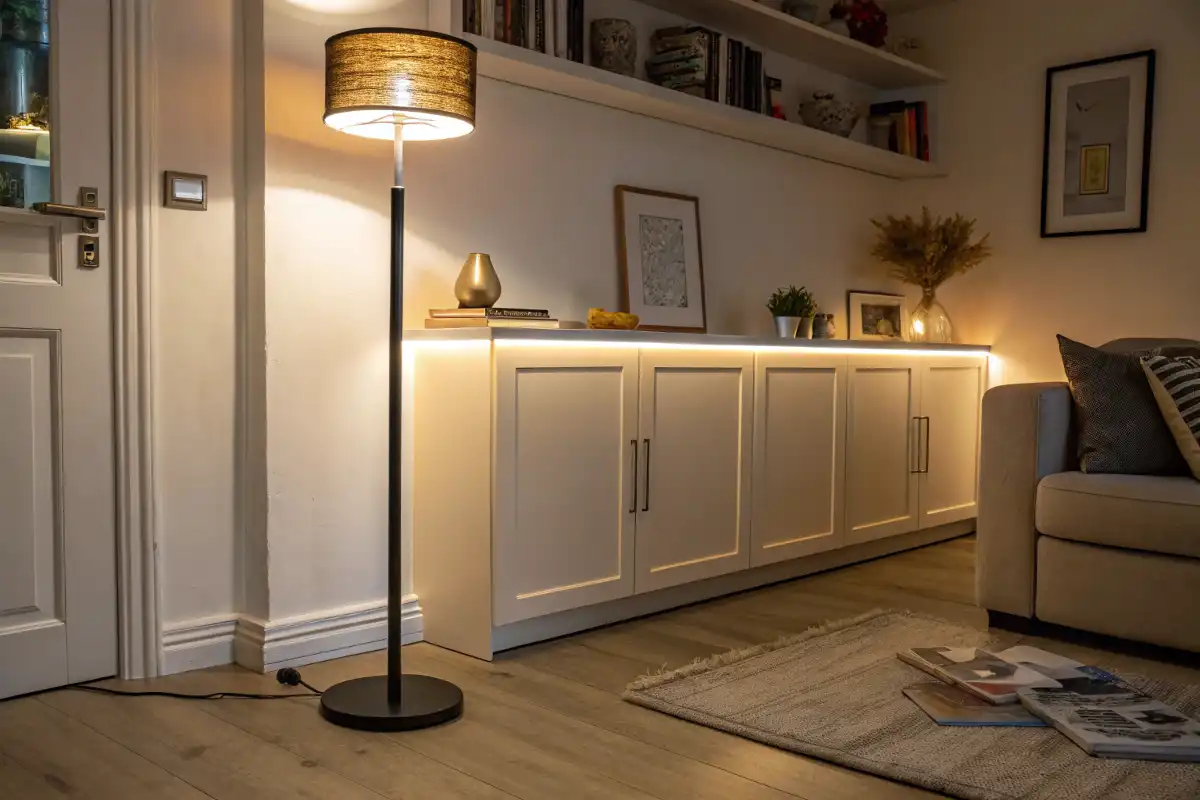
Functional Entryway Zone
Don’t waste precious entry hall space – even a tiny foyer can be a drop zone that keeps clutter in check. Place a narrow console table, floating shelf, or wall-mounted mail organizer just inside the door. Use decorative baskets or bins underneath for shoes or children’s backpacks. Install a few 3M Command hooks at adult and child height for coats, keys, and leashes (no drilling needed). If you have a small wall mirror, make it a quick check-point and visual cue that you’ve left the house with everything. For example, one family-friendly idea is a small bench or ottoman that doubles as shoe storage (just lift the lid) and a seat to help everyone put on shoes. Add a small tray for wallets and phones. By corralling bags, jackets, and mail right at the door, you reduce clutter in the main living area. Keep a short, washable rug by the door to catch dirt from shoes. This makes coming and going smoother for everyone and is a smart way to make even the smallest entry hall do double duty as organizational real estate.
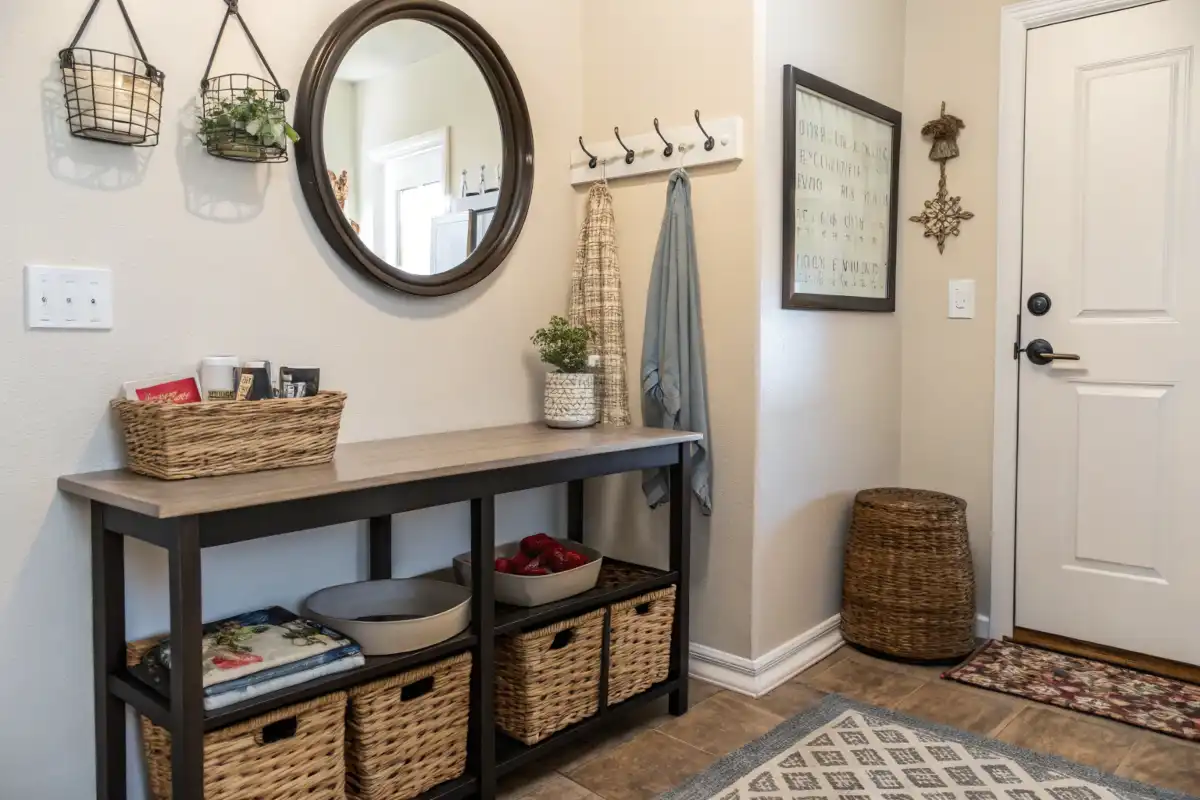
Restful Bedroom Setup
Bedrooms should be peaceful retreats. Start with practical arrangements: if possible, loft or bunk beds (especially for kids) free up floor space underneath for play or a study desk. A twin bed with drawers or a built-in trundle is another space-saver. Position your bed to maximize any natural light and airflow – for example, under or beside a window. Use blackout curtains or lined shades to ensure good sleep, especially for young children. Bedside tables with shelves or a small nightstand give each person a place for books, glasses, or alarm clocks without floor clutter. Clip-on or wall-mounted reading lamps save desk or table space and allow each family member to control their light for bedtime stories or late-night reading. If a bedroom has no window, consider glow-in-the-dark wall stickers or an LED light projector with stars on the ceiling – this is a fun, cordless way to add whimsy (and a night light) for kids without bringing in cords or bulky lamps. Keep bedding cozy and simple; for example, use washable cotton sheets and a down-alternative comforter so kids can enjoy comfort without allergy issues. A tidy, well-lit bedroom with just a few decor pieces (favorite prints on the wall, a small plant on the dresser) will feel larger and more serene, helping everyone in the family get a good night’s rest.
Versatile Living Room Layout
The living room often has to serve many purposes: play space, TV zone, homework spot, maybe even guest bedroom. Choose a modular sofa or sectional (like those with movable pieces) so you can reconfigure seating easily when guests arrive or to open up floor space for playtime. A coffee table with lift-top or storage inside doubles as a toy chest or game table. Floating shelves or a low-profile media console not only save floor space but also provide display areas for photos and books. Keep walking paths clear: maintain at least 2 feet of clearance from furniture to doorways. Consider placing the sofa perpendicular to the window (rather than blocking it) to let sunlight fill the room. If your family enjoys movies together, wall-mount the TV (with a secure bracket) and mount speakers on walls to save floor space. For extra seating, use stools or ottomans that tuck under a console when not in use. Finally, keep a small game or puzzle area with a drawer or cabinet so toys don’t spill onto the couch. A well-organized, adaptable living space means family movie nights, playdates, and study sessions can all happen comfortably without rearranging the whole room each time.
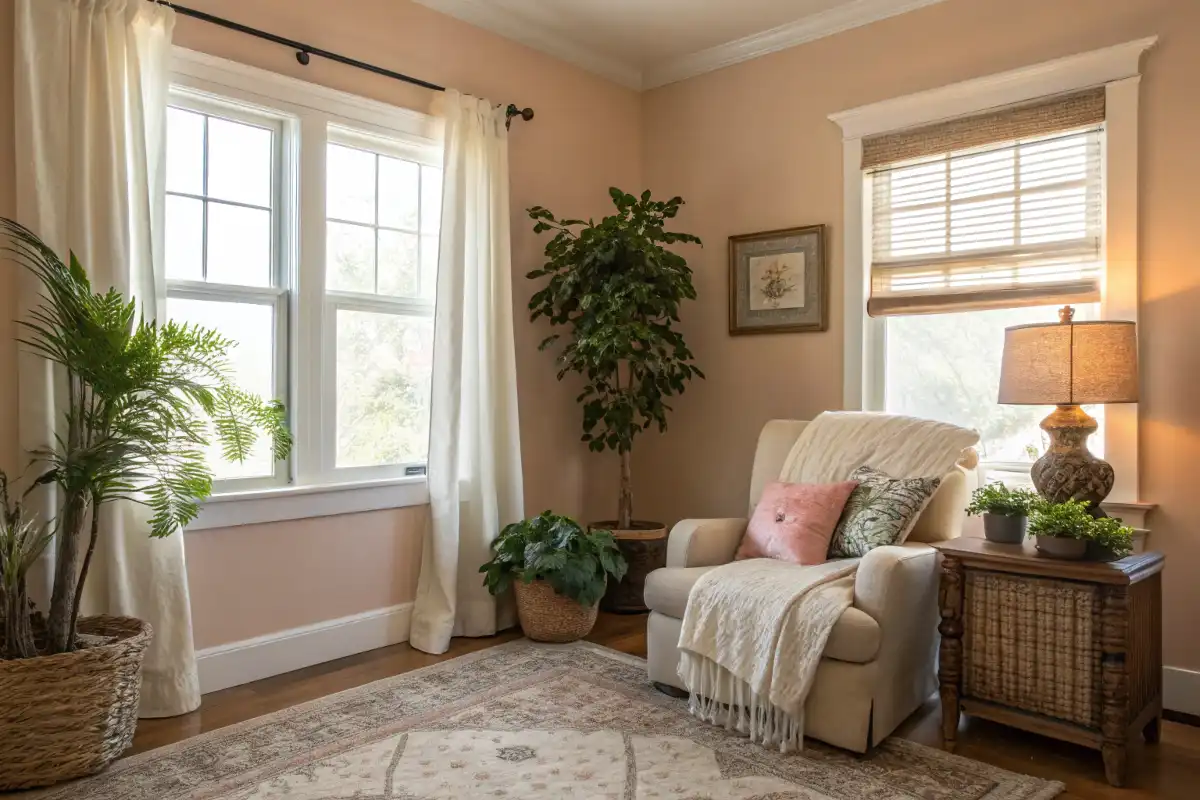
Renter-Friendly Decor Upgrades
Since renting comes with rules, focus on damage-free decor solutions. Removable wallpaper is a game-changer: you can peel it on for an accent wall of pattern or color (think a wall of leafy vines or soft watercolor brushstrokes) and then remove it without a trace. Command hooks and strips let you hang art, a large calendar, or decorative string lights without nails. In the kitchen or bathroom, peel-and-stick tiles or peel-on contact paper can update cabinets and backsplashes in minutes. For artwork and photos, consider magnetic paint or adhesive metal strips; then frames or pictures attach magnetically and can be switched out as the kids make new art. Incorporate smart gadgets that plug in: smart thermostats or lighting panels that don’t need hardwiring. These upgrades add style and function while keeping your deposit safe. For an apartment decor idea that adds life, use a freestanding decorative ladder shelf (no screws needed) to hang throw blankets and baskets. Always keep the packaging of your removable items – landlords may appreciate that you used renter-friendly options when you move out. This way, you personalize your home with minimal fuss and full compliance.
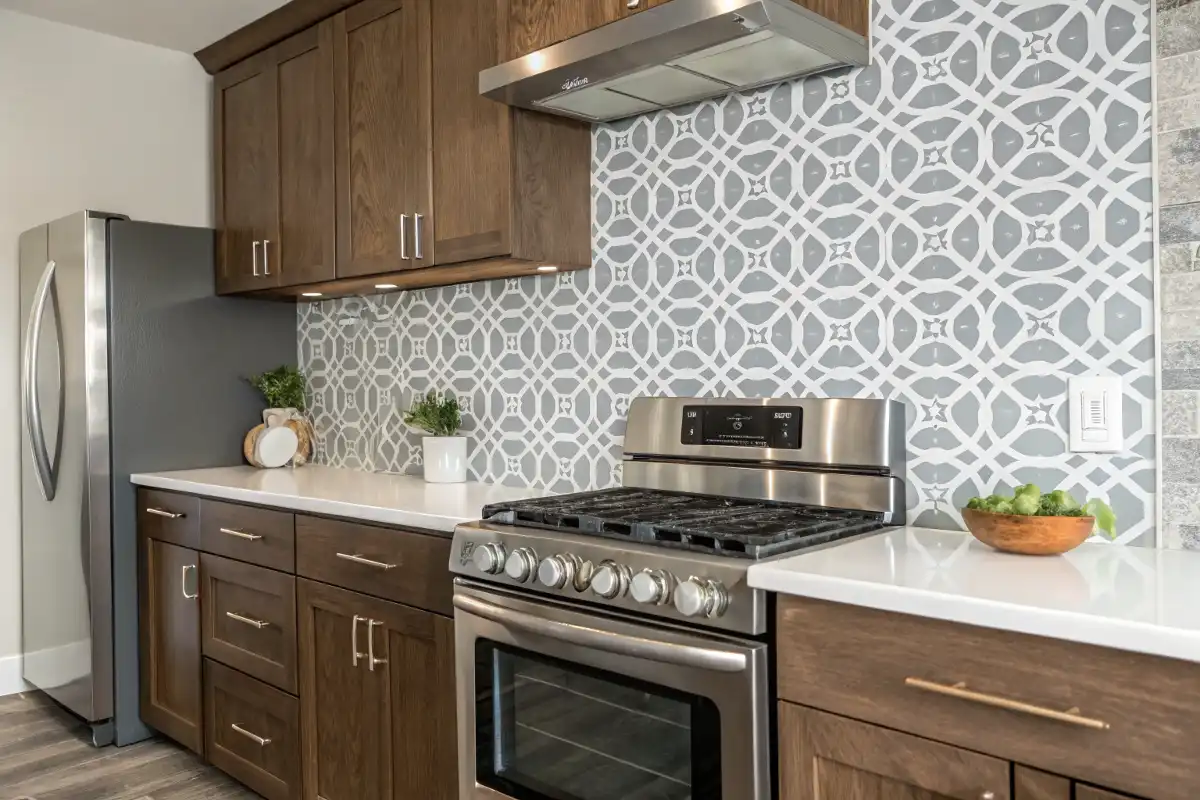
Budget-Friendly DIY Hacks
Great design doesn’t have to break the bank. Get creative with affordable materials to refresh your apartment. For example:
- Tension rods: Use inexpensive metal rods (from $15–30) to create closet shelves, hang curtains, or even suspend plants. They require no drilling.
- Stackable cubes or crates: Inexpensive cubes (often $40–80 each) can be arranged into bookshelves or shoe storage. A few cubes up a wall add tons of vertical storage on a small budget.
- Thrift store finds: Hunt local thrift shops or online marketplaces (Facebook Marketplace, Craigslist) for secondhand dressers or mirrors. A fresh coat of paint (on a drop cloth, outside) can make old furniture look new again.
- DIY art and frames: Frame fabric scraps, children’s drawings, or pages from old books using budget frames for a gallery wall. Even wrapping paper in a frame adds pattern to a wall.
- Dollar store accents: Basic plants, picture frames, or small planters from stores like Dollar Tree or Walmart can be grouped to look custom. Paint them in matching colors to tie them together.
Families can also save by using multi-use containers: for example, pretty baskets for toy storage double as decor. If you plan to stay a while, consider making one splurge – a versatile piece that lasts, like a fold-away Murphy desk or quality rug – and balance the rest with DIY updates. Thoughtful upgrades and repurposed items mean you can achieve a high-end look for a fraction of designer prices.
Clutter Management Habits
No matter how smart your layout is, staying tidy is key in a small home. Adopt simple routines: the “one-in, one-out” rule is gold—every time you buy something new (a toy, gadget, or holiday decoration), donate or recycle an old one. Set aside a box for donations and once it’s full, take it to Goodwill or a shelter. Use clear bins or labeled baskets on shelves so everyone (kids included) knows where things go. For example, a bin under the TV can hold controllers, chargers, and remotes, while a basket by the door catches hats and mittens. Encourage daily quick pick-ups: five minutes before bedtime, do a mini “tornado” where the family races to put things back in place. These small habits prevent clutter from piling up and make your intentional design last longer. Over time, these organization habits let you enjoy the space you’ve created without it feeling chaotic — important when a growing family calls a compact apartment home.
Personal Touches and Family Style
Finally, make your apartment truly yours. Personalize each room with family memories and favorite colors. Create a photo wall with child-safe removable frames or clips for rotating art. Display souvenirs from family trips on a shelf or in a shadow box. Even simple things—like a bright quilt that grandma made, or your child’s handmade crafts on the mantel—inject personality. Don’t forget the small details: a scented candle or diffuser with a fresh scent (like citrus or linen) can make the apartment smell like home. Changeable accents also add character: colorful throw pillows, a chalkboard wall segment for doodling, or a vinyl decal your kids helped pick out. These personal elements may seem minor, but they have a big emotional impact. They signal “this space is ours,” which is the heart of decorating. In the end, creating a small, rented home is about mixing practicality with pieces that make your family smile. Even on a tight budget or lease, your apartment can reflect the warmth and style of your unique family.
Conclusion: Making Smart Spaces Feel Like Home
With these 15 decor ideas, even the smallest apartment can meet your family’s needs without sacrificing personality. The key is balance: marry practical solutions (vertical shelves, multifunctional furniture, renter-friendly upgrades) with soulful touches (warm colors, textiles, and personal mementos). As trends show in 2025, renters who blend function with style end up loving their homes even more. Follow a plan—perhaps tackle one zone or idea per weekend—and watch your space transform step by step. By respecting lease rules (no permanent damage) and focusing on what truly makes you feel at home (comfort, ease, and personal style), you’ll create a living space where your family wants to spend time. Remember, the best apartment decor ideas not only look great but also make daily life easier and more joyful. Armed with these tips, your rented apartment can feel as unique and welcoming as a house of your own.
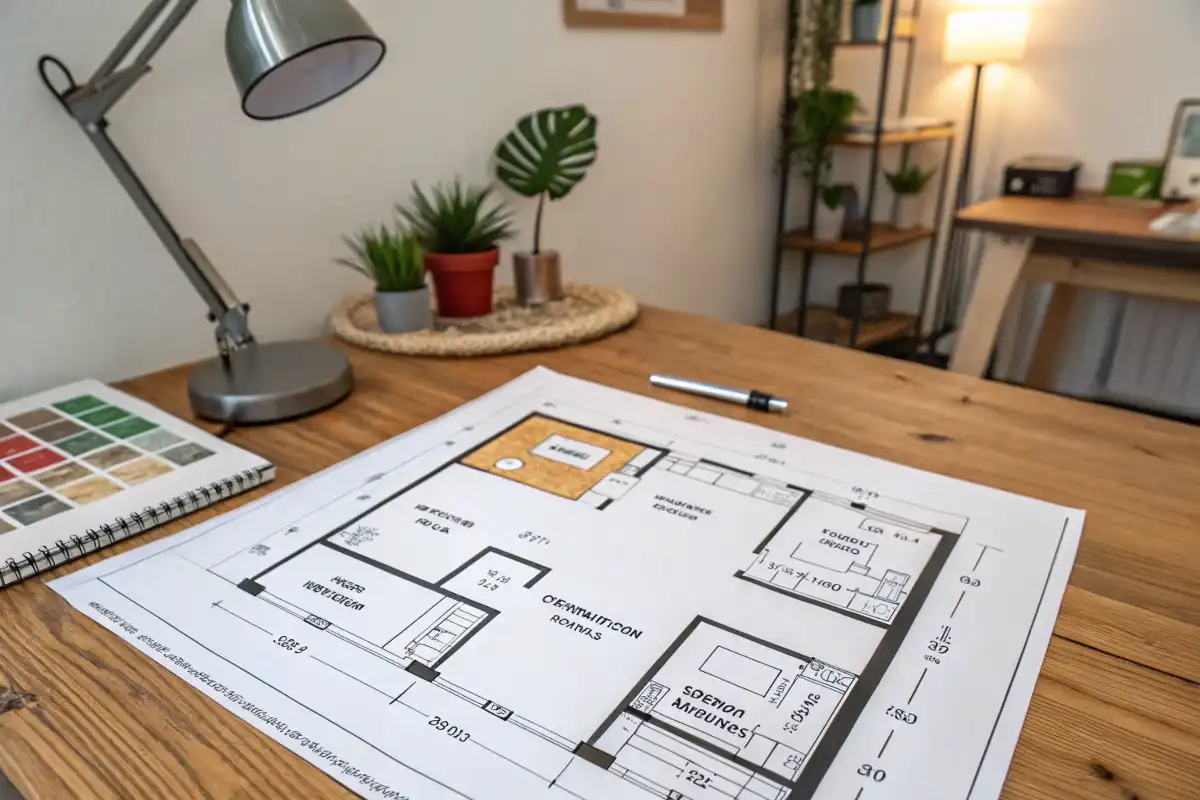
Frequently Asked Questions
Q: What are the most cost-effective rental-friendly storage solutions?
A: Go vertical and DIY. Install tension-rod shelving in closets or corners (you can find tension rods for under $20 each) and use stackable cube shelves with adhesive brackets. These solutions typically run under $100 total and can increase your usable storage by 40–50%. Choose light or white finishes on storage units to keep the space feeling bright.
Q: How can I add personality without painting walls?
A: Removable and non-permanent decor is your friend. Apply removable wallpaper on just one accent wall (or a section of wall) to introduce color or pattern. Use magnetic paint or strips to hang framed art or changeable displays for photos and kids’ artwork. Also, layer in personality with textiles and lighting: patterned pillows, throw blankets, and unique lampshades can make a big impact. Together, these tricks get you most of the effect of a fresh paint job at a fraction of the cost and zero wall damage.
Q: What’s the cheapest way to make a small apartment look larger?
A: Lighten up and go vertical. Paint the ceiling a shade of white or very light color to bounce light around (this is cheaper than major renovations). Add a large mirror or a mirrored cabinet door opposite a window to double the natural light. Use vertical shelving and tall, narrow furniture to draw the eye upward. Even on a budget, combining these tactics – light-reflective paint or decals, well-placed mirrors, and clean vertical lines – can significantly enlarge the feel of a small room. These moves can often be done for under $200 total in supplies.
Q: Which furniture gives the most functionality for a small budget?
A: Look for multifunctional pieces at moderate prices. A quality sofa bed with storage drawers (in the $300–$500 range) serves as seating, guest bedding, and storage. Height-adjustable or fold-out desks ($200–$400) work for work, dining, or play. Nesting tables or storage ottomans ($150–$250 each) act as coffee tables, seats, and tuckaway storage. These items usually have multiple uses and hold their value well. Picking just a few of these key items ensures you get the most bang for your buck in a small space.
tips: By combining these renter-safe upgrades and smart habits, you can maximize style and function while staying within budget – making your small apartment a happy home for the whole family.
